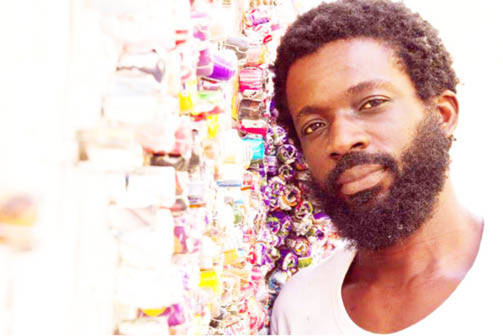How Onadipe is connecting the dots on Lagos exhibition floor
With his artworks occupying every available space within the precinct of the Temple Muse gallery, and the creativities that come with the works conspicuous enough to attract attentions and elicit reactions, artist Olumide Onadipe said he is not holding anything back as he wants to keep connecting the dots for the next three and a […]


With his artworks occupying every available space within the precinct of the Temple Muse gallery, and the creativities that come with the works conspicuous enough to attract attentions and elicit reactions, artist Olumide Onadipe said he is not holding anything back as he wants to keep connecting the dots for the next three and a half months.
Described by his curator, Sandra Mbanefo Obiago as having pieces of artworks that “show amazing artistic dexterity, sensitivity, and breadth in tackling urgent issues of global consumerism against the backdrop of daunting environmental pressures, facing millions of Africans every day,” Onadipe said the reality he seeks to reflect in every of his works are products of painstaking conceptions and imaginations.
With over 40 artworks of different shapes and sizes made up of paintings and sculptural pieces, the ambitious Onadipe said he does not want to be known within a section of the art world but desirous of leaving his footprints in as many specialties as possible.
“When I started, I was rather known as a sculptural artist. But I know I am gifted in other aspects of art,” Onadipe said, addressing journalists. “Today, when people see my paints, they are wowed, and ask, ‘are you the one who did this as well?’ Well, that is the point for me. In arts, there is convergence and those are the dots I am connecting.”
In retrospect of materials he has had to deploy to create his pieces, Onadipe said, “The materials I explore include, polythene bags, newspapers, jute and cement bags, electrical cables, ink, paint, wood, and metal that reflect ‘ordinary’ Nigerian life and question our consumerism.”
A 2008 graduate of Painting from the University of Nigeria (UNN) Nsukka, Onadipe said the Pan-Africanism in him has been a major driving force of his innovativeness. Though, he lamented that it is quite unfortunate that “a continent that once supported the economy of the rest of the world, now has need for support and a people of earliest inventors and inventions have become consumers.”
Obiago, who is also the artistic Director of SMO Contemporary Art, described Onadipe as Nigeria’s “fast rising visual artist” whose thought-provoking works often give birth to creative masterpieces. “His signature sculptures, made from up-cycled and re-purposed plastic shopping bags, water sachets, juice packs, cement bags and newspapers are presented alongside his paintings, which are a continuation of his eclectic palette of rich materiality and textural freedom, showing human forms emerging out of intricate tangles of roots and leaves,” Obiago said.
According to the Curator, Connecting the Dots, exposes the different layers of Onadipe’s artistic personality in which he grapples with identity and migration vis-à-vis a universal yearning for global citizenship and communication across a world of bold colour.
“As you can see, Onadipe’s interpretations of these universal themes are presented through the tying, knotting, folding and melting of vibrant re-purposed materials used to create striking sculptures with life size legs and geometric shaped torsos and heads. They are a powerful counterpoint to the delicate brushstrokes of his paintings depicting human forms yearning towards emotional harmony and environmental balance,” she said.
“In Connecting the Dots we see an artist who boldly questions the status-quo, and whose art has swept him to the very cusp of the rising tide of contemporary art coming out of Nigeria,” said Jess Castellote, an art critic. “His expression is in-sync with the aspirations of millions of Nigerian youth trying to seek better livelihoods within a totally overburdened natural and political ecosystem.”
Castellote said, “For those of us who have followed him for more than a decade, his new works do not present themselves as a surprise or a rupture, but as an evolution and deepening of ideas and formal solutions. He is finding an aesthetic vocabulary and a formal language that allows him work with ideas and meanings in a much more forceful way.”
Despite still evolving in the art world, Onadipe said he has taken part in numerous exhibitions in the United Kingdom, Ghana, and Nigeria and that he is already in important local and international collections.
